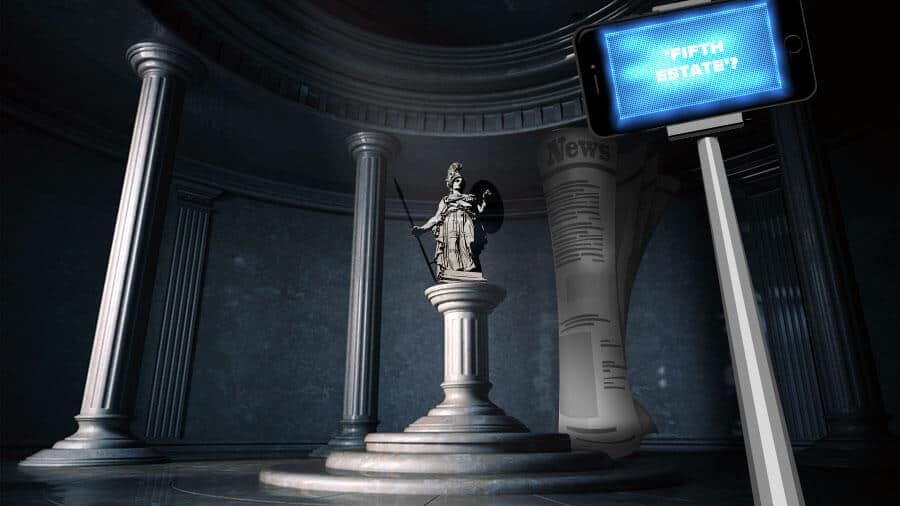With all the changes occurring in ‘traditional journalism’ during the digital era, is it being challenged to the point of losing its synonym as the “fourth estate? Is this concept shifting in practice and what we call journalism at least the fifth estate? What should we know when drawing a parallel between journalism and Public Relations (PR) and what’s the importance of Media and Information Literacy (MIL) in building an environment with readers who are able to critically access, analyze and evaluate information?
The legislature, executive, judiciary and the media. This is the order we usually follow when symbolically illustrating the profound power of media in democratic countries. The term “fourth estate” presents the press, media and journalists playing a crucial part in society. An indirect, sometimes hidden, yet very powerful, role in influencing and shaping the political and public sphere.
A brief background
This term, also known as “fourth power” describes media ability to significantly influence the system. It is attributed to Edmund Burke, who used it in a parliamentary debate in 1787. It was Thomas Carlyle, who in his book, On Heroes and Hero Worship, described the exact words: “Burke said there were Three Estates in Parliament; but, in the Reporters’ Gallery yonder, there sat a Fourth Estate more important far than they all.”
Nowadays, journalism is accompanied with various changes occurring with each day passing by. With all the development on technology, digitalism, data journalism, and the expansion of social media platforms as means of information, journalism is, to some extent, reshaping and being challenged in more than one way.
However, are these challenges enough to doubt the role of the media as the “fourth estate”?
Journalism never stopped being the fourth estate

Gentianë Paçarizi, Media and Information Literacy consultant, who initiated the first Media and Information Literacy (MIL) magazine in Kosovo while serving as teaching assistant at the University of Prishtina “Hasan Prishtina”, Department of Journalism, is of the opinion that journalism never stopped being the fourth estate, however she says that its position has and is being challenged.
In this interview she elaborates more in differences between the traditional and new media and the role of journalists in the digital landscape, on what one needs to know and practice with regard to engage and interact with media and information landscape, namely Media and Information Literacy (MIL), which stands as a mix of knowledge, attitudes, skills, and practices required to access, analyse, use and communicate information and knowledge in creative, legal and ethical ways that respect human rights.
What’s behind the ‘fifth estate’?
Journalism has never stopped being the fourth estate, however this position has and is being challenged.
“In the US, the “fifth estate” has come to be known as part of the counter-culture movement back in the ‘60s where underground newspapers emerged, such as The Fifth Estate underground newspaper, which were supposed to be an alternative to the fourth estate, namely, traditional media.
Now, when we talk about the fifth estate, some talk about bloggers, journalists that publish in non-mainstream media and the networking of individuals enabled by social media networks.
Digital era: Where every Internet user has a printing press

According to her, the development of technology has shaped the media institution by requiring them to re-invent themselves and also brought many variations to journalism.
“While traditional media continues to be the fourth estate, technology has given rise to alternative entry points for non-traditional media where journalism is not exclusive to mainstream media, but inclusive of every potential citizen. It is said that in the digital era, every Internet user has a printing press.
“This development has its strengths and flaws,” Paçarizi says, by further adding that if we talk about its strengths, we see that citizens are empowered to connect into a network in ways that enable a new source of accountability in government, politics and other sectors, but also in traditional media.
She recalls that the digital landscape provides a platform for individuals to voice their concerns and promote their causes without being mediated by a third party.
This, in turn, results in a media and digital landscape that is far more inclusive of the diversity of voices as such.
However, Paçarizi explains that in a public space where trust in traditional media is deteriorated and some citizens may look for alternative information sources, this development’s flaws derive from suspicious information quality put out there and lack of critical skills to engage with it.
“While digital landscape gives a platform to individuals to express themselves and choose their own information sources, it also enables a non-filtered and unverified availability of information that goes under no scrutiny before being published. In credible media, the publication of a piece undergoes a systematic overview. In the digital landscape, you may be your own journalist, editor and publisher.”
Conclusively, she says that no one can stop you from skipping fact-checking rather than your own ethics.
Qualitative journalism and how it is being challenged
In previous pieces, we discussed the extraordinarily rapid changes that are occurring due to recent technological advances and also about the role of the media in society’s democratisation. The both of these stand closely to qualitative journalism, which we also discuss with Paçarizi – who believes that in some ways, the media market is now democratised.
“However, I hold that qualitative journalism, in most cases deriving from well-established media, is now more important than ever.”
“In an environment where you can literally get information from multiple sources, credible information sources that go under verification of facts, present facts in context and explain the developments in an unbiased manner become crucial to shaping our attitudes and beliefs.”
Moreover, she says that in all this development, qualitative journalism is faced with unprecedented challenges.
“The deterioration of trust in the media has led some citizens to look for alternative sources which are not always credible, but may comfort and confirm their biases. In this regard, qualitative journalism has to lead the battle in many fronts. Not only it needs to keep government, politics and other sectors under check, but also keep media users informed on the way they are being informed,” says Paçarizi.
Moreover, as per her opinion, it has to reinvent itself on a regular basis as to respond to audience’s behavior changes, which are constant.
Media and information Literacy and why it matters
With all the accessible online platforms, one might often face the dilemma of what to read, or more importantly what to believe. For this, we take a look at the Media and Information Literacy (MIL) concept and its meaning.
Paçarizi believes that present to a digital landscape flooded by polluted information, citizens need to be empowered with MIL skills to critically access, analyze and evaluate information.
“Moreover, they also need to be empowered to produce and communicate information and knowledge in creative, legal and ethical ways that respect human rights. “
“Undoubtedly, these skills, namely MIL, are a complementing part of the fifth estate.”
She further mentions the “ethical responsibility” as a key component toward contributing in the public sphere as a journalist.
“If we are to contribute to the public space with providing information or serve as alternative information sources, thus make use of the possibilities the media democratized market now provides, we need to hold ethical responsibility, for example, not provide non-reliable information that incites discrimination, hate speech, or any other harmful phenomenon. “
Speaking from her experience, she says that the problem is not the rapid technology development.
“…But rather that disseminating media and information literacy skills and attitudes doesn’t go in the same pace as the former. Nowadays, information is omnipresent, hence the need of critical filters that accompany us to filter what our brains consume, which in turn shapes our attitude, beliefs and actions. “
Journalism ‘Versus’ Public Relations
Nowadays, with all the technological advancement and the rise of social media usage as a means of information, one often hears Public Relations (PR) as a derivative of journalism. However, where’s the place of journalism now in relation to PR.
Should we see them complementing or competing with -other?
Paçarizi answers this by initially saying that “PR doesn’t really have to do anything with journalism.” She reminds us that the basic standard for journalism is to be objective and unbiased through balancing point of views on a development.
“While PR is a means through which a grouping polishes their public image through presenting only their side of the story. The problem in the digital area in this regard is that there are citizens who can’t differentiate these two and take PR at face value and sometimes, there might be media who are biased. But, this doesn’t have anything to do with qualitative journalism and media.”
“Again, with media and information literate citizens, qualitative journalism wins an ally because then they can easily tell what makes it for qualitative journalism and what not.”
Photos: Shutterstock / Photomontage: Martina Advaney; Loriana Paçarizi
This piece is published as a part of a series to three previous pieces on Media Literacy including:
Support us!
All your donations will be used to pay the magazine’s journalists and to support the ongoing costs of maintaining the site.
Share this post
Interested in co-operating with us?
We are open to co-operation from writers and businesses alike. You can reach us on our email at [email protected]/[email protected] and we will get back to you as quick as we can.










